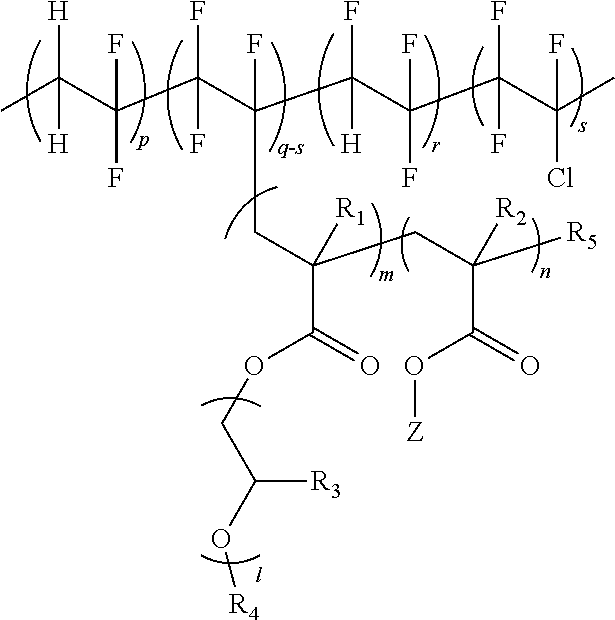Electrode protective layer polymer and secondary battery to which same is applied
- Summary
- Abstract
- Description
- Claims
- Application Information
AI Technical Summary
Benefits of technology
Problems solved by technology
Method used
Image
Examples
preparation example (
2-3) Preparation of Grafting Copolymerized PVDF-co-(PCTFE-g-P(mPEGMA-co-(HEMA-AOI)))-co-PTrFE (A2-3)
[0192]In a 1000 ml flask, 15 g of P(VDF-co-CTFE-co-TrFE) having a weight average molecular weight (Mw) of 560,000 as a fluorine-based polymer, and 116 g of mPEGMA (ethylene oxide repeating number=9), and 0.70 g of HEMA, as monomers to polymerize, were introduced to 350 ml of a dimethylformamide (DMF) solvent, and were stirred for 1 hour under the nitrogen condition.
[0193]After that, 0.003 g of CuCl2 as an ATRP reaction catalyst, 0.014 g of TPMA as a ligand, and 0.04 g of AIBN as a reducing agent were introduced to the flask, and the ATRP reaction was proceeded for 30 hours at 60° C. under the nitrogen condition with stirring. Herein, the monomer conversion rate was 80%.
[0194]After the polymerization was completed, the reaction material was cooled to room temperature, and air was bubbled into the reaction vessel for 2 hours. 0.0004 g of 2,6-bis(1,1-dimethylethyl)-4-methylphenol (BHT) w...
examples 1-1 to 1-5
Preparation of Cured Electrode Protective Layer
[0198]Each of the fluorine-based graft polymers prepared in Preparation Examples 1-1 to 1-3 was mixed in a weight ratio (pt) as written in Table 3, and stirred for 6 hours to prepare a thermocurable polymer solution. The solution was coated on a 2 cm2×0.1 cm circular SUS substrate in a dry room, heated for 5 hours at a temperature of 60° C. for drying, and further thermally cured for 2 hours at 120° C. After that, the result was vacuum dried for 48 hours at 60° C. to prepare a completely dried polymer electrode protective layer. The amount of the coated polymer solution was adjusted so that a thickness of the final electrode protective layer becomes approximately 100 μm.
Comparative Examples 1-1 to 1-3 Preparation of Cured Polymer Film
[0199]The polymer prepared in Comparative Preparation Example 1-1 and a P(VDF-CTFE) copolymer was mixed in a composition as in Table 3, and stirred for 6 hours to prepare a homogeneous solution. After that,...
examples 2-1 to 2-5
Preparation of Cured Electrode Protective Layer
[0201]Each of the fluorine-based graft polymers prepared in Preparation Examples 2-1 to 2-3 was mixed in a weight ratio (pt) as in Table 4, and stirred for 6 hours to prepare a photocurable polymer solution. The solution was coated on a 2 cm2×0.1 cm circular SUS substrate in a dry room, and then exposed to a metal halide lamp for 3 minutes. After that, the result was vacuum dried for 48 hours at 60° C. to prepare a completely dried polymer electrode protective layer. The amount of the coated polymer solution was adjusted so that a thickness of the final electrode protective layer becomes approximately 100 μm.
Comparative Examples 2-1 to 2-3 Preparation of Cured Polymer Film
[0202]Each of the polymers prepared in Comparative Preparation Examples 2-1 and 2-2 was mixed in a composition as in Table 4, and stirred for 6 hours to prepare a homogeneous solution. After that, the same cured film preparation method as the example was used to prepar...
PUM
| Property | Measurement | Unit |
|---|---|---|
| Percent by mass | aaaaa | aaaaa |
| Percent by mass | aaaaa | aaaaa |
| Percent by mass | aaaaa | aaaaa |
Abstract
Description
Claims
Application Information
 Login to View More
Login to View More - R&D
- Intellectual Property
- Life Sciences
- Materials
- Tech Scout
- Unparalleled Data Quality
- Higher Quality Content
- 60% Fewer Hallucinations
Browse by: Latest US Patents, China's latest patents, Technical Efficacy Thesaurus, Application Domain, Technology Topic, Popular Technical Reports.
© 2025 PatSnap. All rights reserved.Legal|Privacy policy|Modern Slavery Act Transparency Statement|Sitemap|About US| Contact US: help@patsnap.com



